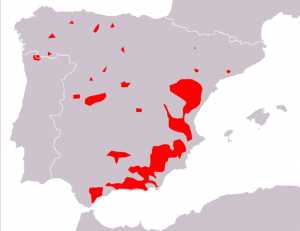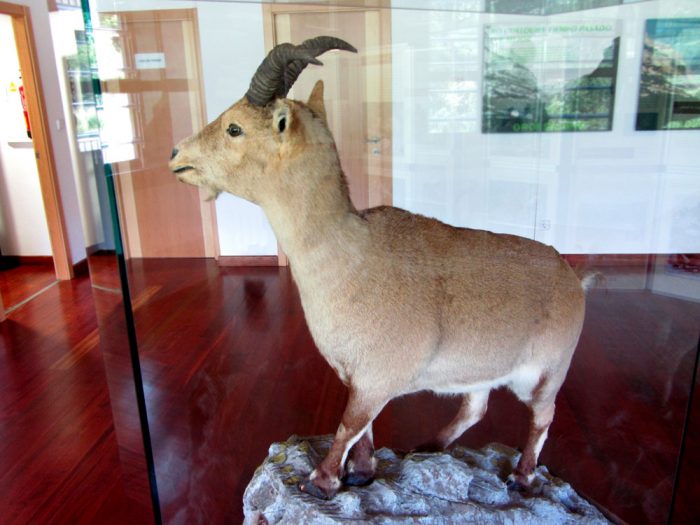
Plate 22 (Spanish Tur) from Richard Lydecker (1898) Wild oxen, sheep and goats of all lands, living and extinct. Based on a sketch by Joseph Wolf in the possession of Lady Brooke.
Pyrenean Ibex Capra pyrenaica pyrenaica – bouquetin (fr) – bucardo or cabra montes (sp) – herc (cat)
Capra pyrenaica pyrenaica, the Pyrenean ibex, is the only (sub)-species to have gone extinct twice. The first time on 6 January 2000 and the second time on 30 July 2003. Despite this double-barrelled failure, another subspecies of Iberian ibex (Capra pyrenaica victoriae) is now thriving in the Pyrenees following reintroduction. Hunters’ attitudes and hunters’ money have played a big part on both sides of the equation.
The Pyrenean ibex was first said to be on the verge of extinction in 1825, but the only difference this made was to increase the value of a trophy on the walls of stately homes. It was all about horns. In Big Game Shooting (1894), the authors were at pains to compare lengths and girths. Sir Victor Brooke’s longest horns measured 780mm. The artist’s impression (above) does indeed show an impressive beast.
As well as having big horns, the ibex had a second problem for its survival: its defensive strategy was to climb onto near-vertical cliff faces, inaccessible to normal predators, but plainly visible in gunsights. Thus it was that the fate of the Pyrenean subspecies and the other three Iberian subspecies lay in the hands of a few hunters, often aristocrats. Fortunately, the leader of the pack, King Alfonso XIII, turned out to be more responsible than most. Realising that extinction was near, he became interested in ibex conservation. By 1905 there were said to be only eleven in the Sierra de Gredos near Madrid and perhaps a few hundred in the whole country. The Gredos landowners ceded hunting rights to the king, who made the intelligent choice of employing the best local hunters as guards, thus giving them an interest in protecting ibex rather than poaching them. The population rebounded.
Once hunting stopped, ibex recolonised areas where they had been unknown. In Spain they can now be found in Cantabria (NW Spain, –15°C in winter, 2000mm of rain) and on the shores of Andalusia (Southern Spain, 40°C in summer, only 200mm of rain). They have lost much of their fear of humans. Walking in Andalusia one winter, I came across three kids. They stared at me inquisitively, jumping onto a rock to get a better view. When I finally moved on, they leapt away but stopped and turned around after a few paces.
In general, starting in 1905, the Iberian ibex population has been growing. Except in the Pyrenees, where these herbivores were on a different trajectory, despite measures to safeguard them. The wilder, Spanish side of the mountains favoured by Brooke would emerge as the Ordesa National Park in 1918. As long as ibex didn’t stray beyond its borders, they would be safe, at least in theory.
Meanwhile, the first eco-tourist of renown arrived in the Ordesa valley. Russian prince Teodoro de Tchihatchef wanted to see – but not kill – ibex. After two unsuccessful weeks he was about to leave when he was persuaded to stay for just one more day. Miracle! For the first time, when he scanned the cliffs with his binoculars, he saw an ibex: over a kilometre away. He insisted on going to look. Naturally, by the time he arrived the animal had wandered off – even though it was stuffed. But the prince was so pleased that he engaged the guides for another fortnight.
It is a tale that encapsulates the 20th-century history of the Pyrenean ibex. Separated from its Alpine brethren by the width of France and from the other peninsular ibex by the river Ebro, the numbers were decreasing. Inbreeding was becoming a problem. By now, there was little chance of seeing one, except in a glass case.
A century later, the only place you can see a genuine Pyrenean ibex is in a glass case, like the one in the Ordesa National Park visitor centre. Celia, as this ibex was called, was the last Capra pyrenaica pyrenaica, the one that died on 6 January 2000. A branch fell on her. Her tracker stopped moving. A team went out to recover the body. Previous attempts to mate her had failed. She was the end of the line. Except that three years later she was brought back to life. The cloning of Celia was the first successful attempt to resuscitate an extinct species. Unfortunately, the kid died within a few minutes with breathing problems.
Curiously, the scientists who achieved this exploit kept it secret for five years. Were they nervous about reactions? In any case, by 2008 they decided to seek grants to try again. By 2014, they were on the verge of success, thanks to financial help from the Aragon Hunters’ Association, when they ran out of money. Their work was controversial because Celia was ‘old, sterile, with a high degree of inbreeding and had congenital heart problems’. It was also argued that ‘nature isn’t a static context but moving’. Other animals like the isard have already changed the environment, some scientists pointed out.
Meanwhile, on the French side of the Pyrenees, a more conventional strategy was emerging. The Pyrenees National Park had been considering reintroductions since the 1970s. In 2002 the Pyrénées-Atlantiques hunters got behind the idea. By 2009 the Ariège hunters were chaffing at the bit and the newly born Ariège Pyrenees Natural Park included reintroductions in its objectives.
But, despite a population that had risen to 50,000, the Spanish were reluctant to let any ibex go: ibex hunting is big business. Taking home a pair of horns from a dominant male can cost up to 20,000€ when all the expenses of the hunt are taken into account. Exporting live ibex was made illegal. So, when the first official requests were made, the Spanish were suspicious of the motivations, particularly as the hunting associations were the big guns behind the scenes. It was only when the French government protected the species that things began to change. Finally, thirty-eight ibex (Capra pyrenaica victoriae from Guadarrama) were released in the summer of 2014. More reintroductions followed and there are now over three hundred.
For good or bad, hunters have been key conservation stakeholders. It is dangerous to ignore a man with a gun.
More on the Pyrenean ibex [in Spanish]













[…] So the Pyrenean ibex remains extinct. Here’s the taxidermied body of Celia. Source […]